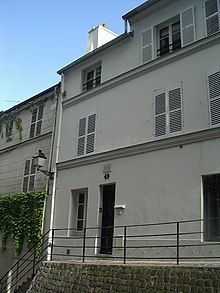Musée-Placard d'Erik Satie

The Musée-Placard d'Erik Satie (Cupboard Museum of Erik Satie) was a miniature museum dedicated to composer Erik Satie (1866–1925). Founded in 1983 and curated by veteran Satie scholar Ornella Volta,[1] it was located in the 18th arrondissement of Paris at 6 Rue Cortot, Montmartre, France.

The "cupboard" museum consisted of a small utility room, measuring 3x3 meters (just under 10x10 feet), that Satie lived in from July 1896 to October 1898. From 1890 he had previously occupied a larger room in the same building, but dire poverty forced him to move into this unheated ground floor closet, which the landlord offered him for 20 francs per quarter.[2] The space was so small that Satie's camp bed blocked the door from fully opening, and on frigid nights he kept warm by sleeping fully dressed with the rest of his clothing piled on top of him.[3][4][5] He wrote very little music there, primarily the Pièces froides (1897).
Reputedly one of the smallest museums in the world, it was not an actual reconstruction of the composer's prison cell-like living quarters. It displayed items that belonged to Satie, mainly drawings and portraits, as well as an authorized replica of artist Man Ray's readymade sculpture The Gift (1921), the original of which Satie himself helped create.[6][7] Instead of a bed there was an upright piano, and on one occasion Volta sponsored an 18-hour performance of Satie's piano piece Vexations there. The audience consisted of guests who were allowed into the room two at a time.[8]

Due to lack of subsidies, Volta was forced to close the Musée-Placard d'Erik Satie in 2008. She died in 2020 at age 93, having devoted nearly 50 years to researching and writing about Satie's life and works. A commemorative plaque to the composer hangs above the entrance of 6 Rue Cortot.
See also
References
- ^ Melville, Antony (2020-11-01). "Ornella Volta obituary". the Guardian. Retrieved 2023-01-18.
- ^ Robert Orledge, "Satie the Composer", Cambridge University Press, 1990, p.xxiv.
- ^ Pierre-Daniel Templier, "Erik Satie", MIT Press, 1969, p. 20. Translated from the original French edition published by Rieder, Paris, 1932.
- ^ Mary E. Davis, "Erik Satie", Reaktion Books, 2007, p. 60.
- ^ J. P. Contamine de Latour, "Erik Satie intime: souvenirs de jeunesse", Comoedia, 3, 5, 6 August 1925. Reprinted in Robert Orledge, "Satie Remembered", Faber and Faber Ltd., 1995, p. 28.
- ^ Billy Kluver and Julie Martin, "Kiki's Paris", Harry N. Abrams, Inc., Publishers, NY, 1989, p. 102.
- ^ Stańska, Zuzanna (2017-10-29). "Learn More About Man Ray's Cadeau". DailyArt Magazine. Retrieved 2023-01-18.
- ^ Melville, "Ornella Volta Obituary"
- Le Nouvel Observateur, Week of Thursday 25 June 1998
- Paris.org entry
- Planetware entry
- ParisInfo entry (French)[permanent dead link]
- v
- t
- e
- Jack in the Box
- Mercure
- Parade
- Relâche
- Danse
- Le Bœuf Angora
- La belle excentrique
- Trois petites pièces montées
- Bonjour Biqui, Bonjour!
- Ludions
- Messe des pauvres
- Quatre petites mélodies
- Socrate
- Trois mélodies
- Trois poèmes d'amour
- Allegro
- Aperçus désagréables
- Avant-dernières pensées
- Chapitres tournés en tous sens
- Croquis et agaceries d'un gros bonhomme en bois
- Danses gothiques
- Descriptions automatiques
- Embryons desséchés
- Enfantines
- Fête donnée par des Chevaliers Normands en l'honneur d'une jeune demoiselle (XIe siecle)
- Gnossiennes
- Gymnopédies
- Heures séculaires et instantanées
- Le Piccadilly
- Le poisson rêveur
- Les trois valses distinguées du précieux dégoûté
- Nocturnes
- Ogives
- Petite ouverture à danser
- Pièces froides
- Poudre d'or
- Prélude d'Eginhard
- Prélude de la porte héroïque du ciel
- Préludes flasques (pour un chien)
- Premier Menuet
- Sarabandes
- Sonatine bureaucratique
- Sonneries de la Rose+Croix
- Sports et divertissements
- Trois morceaux en forme de poire
- Veritables Preludes flasques (pour un chien)
- Verset laïque et somptueux
- Vexations
- Vieux sequins et vieilles cuirasses
- Choses vues à droite et à gauche (sans lunettes)
- Cinq grimaces pour Le songe d'une nuit d'été
- En habit de cheval
- Geneviève de Brabant
- Je te veux
- La Diva de l'Empire
- La statue retrouvée
- Le Fils des étoiles
- Le piège de Méduse
- Les Pantins dansent
- Petit prélude de 'La Mort de Monsieur Mouche'
- Salut drapeau!
- Sonnerie pour réveiller le bon gros Roi des Singes
- A Romance
- Entr'acte (1924 film)
- Furniture music
- Metropolitan Church of Art of Jesus the Conductor
- The Minimalism of Erik Satie
- Monotones (ballet)
- Musée-Placard d'Erik Satie
- Surrealist music
- The Gift (1921 sculpture)
- Ornella Volta
 Category
Category Audio
Audio














